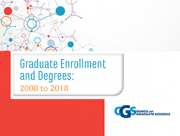You are on CGS' Legacy Site.
Thank you for visiting CGS! You are currently using CGS' legacy site, which is no longer supported. For up-to-date information, including publications purchasing and meeting information, please visit cgsnet.org.

PRESS RELEASE
EMBARGOED UNTIL: October 8, 2019, 12:01 a.m. EDT
CONTACT: Katherine Hazelrigg / (202) 461-3888 / khazelrigg@cgs.nche.edu
Washington, DC — Today the Council of Graduate Schools (CGS) reported that graduate applications (2.2%) and first-time graduate enrollment (2.1%) increased overall and across all institution types (Doctoral Highest, Higher, and Moderate Research Institutions and Master’s Colleges and Universities) for Fall 2018. While the overall numbers are on the rise, first-time graduate enrollment of international students continues to decline (-1.3%). The data are part of the latest CGS/GRE Graduate Enrollment & Degrees: 2008-2018 report.
“The increases in application and first-time enrollment rates for Fall 2018 after last year’s slowdown is encouraging news for graduate education. We’re especially pleased to see increases in first-time enrollment among Latinx (6.8%), Black/African American (3.5%), Asians/Pacific Islander (6.2%), and American Indian/Alaska Native (8.3%) graduate students,” said CGS President Suzanne Ortega. “However, we do take note of the continued decline in the number of international students pursuing graduate education in the U.S. As we move to an increasingly globalized economy and workforce, domestic students benefit from training alongside international students, who also make important contributions to graduate education and research and the U.S. economy.”
Enrollments Continue to Align with Fastest Growing Fields
Enrollment trends by broad field of study are consistent with data from the last two years. Between Fall 2017 and Fall 2018, the largest one-year gains in first-time enrollment by broad field of study were in mathematics and computer sciences (4.3%), health sciences (3.3%), and education (3.2%). In contrast, applications and first-time graduate enrollment in engineering over the same period declined 6.9% and 4.6%, respectively. These results are consistent with findings from CGS’s International Graduate Applications and Enrollment: Fall 2018 survey, indicating that the decline in engineering enrollment is largely driven by a decrease in international students.
“Between Fall 2008 and Fall 2018, first-time graduate enrollment in mathematics and computer sciences has increased 11.0% and health sciences by 6%. Based on our data, these are the fastest-growing fields in graduate education and many jobs within them require advanced degrees,” said Ortega. “The steady growth in first-time enrollment in these fields indicates graduate education’s continued alignment with recent Bureau of Labor Statistics data on employment projections. These findings suggest that incoming students recognize the expanding employment opportunities in these growing fields, as well as the role they play in driving innovation.
Institutions responding to the CGS/GRE Survey of Graduate Enrollment & Degrees for Fall 2018 enrolled more than 1.8 million graduate students. Nearly three-quarters (73.9%) of total graduate enrollment was in master’s programs. Over one million of those graduate students, or 58.2%, were women. The three largest broad fields of study (business, education, and health sciences) were also the fields with the largest proportions of part-time graduate students (Business: 62.9%; Education: 51.2%; Health Sciences: 41.5%).
Other report findings are summarized below.
Findings by Broad Field
- By broad field of study, the largest number of total applications for Fall 2018 were in engineering (284,512), business (278,775), and health sciences (270,580). These three broad fields alone accounted for 40.7% of all graduate applications for which the intended field of study was known in Fall 2018.
- Mathematics and computer sciences (4.3%) and health sciences (3.3%) reported the largest one-year gains in first-time graduate enrollment between Fall 2017 and 2018.
- The one-year change in first-time graduate enrollment in engineering was -4.6%, compared to -3.8% between Fall 2016 and 2017.
Findings by Degree Level
- The largest one-year percentage increases in doctoral applications were in mathematics and computer sciences (18.6%) and public administration and services (12.9%).
- The largest one-year percentage increases in the number of master’s applications were in social and behavioral sciences (9.3%) and mathematics and computer sciences (5.4%).
- Of the graduate certificates awarded in the 2017-2018 academic year, 62.0% were from public institutions, 33.7% from private, not-for-profits, and 4.4% from private, for-profit.
Findings by Student Demographics
- In Fall 2018, approximately 24.1% of all first-time U.S. citizens and permanent resident enrollees were underrepresented minorities. American Indian/Alaska Native, Black/African American, and Hispanic/LatinX first-time graduate students remain particularly underrepresented in STEM fields.
- In Fall 2018, the majority of first-time graduate students at all degree levels were women – 59.7% at the master’s degree and certificate level and 54.4% at the doctoral level.
- Among first-time graduate enrollment, 80.2% were U.S. citizens and permanent resident graduate students in the Fall of 2018 and about 19.8% were international.
- International students comprised the largest share of first-time graduate students in mathematics and computer sciences (55.6%), followed closely by engineering (51.0%).
About the report
Graduate Enrollment and Degrees: 2008 to 2018 presents the findings of an annual survey of U.S. graduate schools, co-sponsored by CGS and the Graduate Record Examinations (GRE) Board. It is the only annual national survey that collects data on graduate enrollment by all fields of study and is the only source of national data on graduate applications by broad field of study. The report includes responses from 589 institutions and presents statistics on graduate applications and enrollment for Fall 2018, degrees conferred in 2017-18, and trend data for one-, five- and ten-year periods.
###
The Council of Graduate Schools (CGS) is an organization of approximately 500 institutions of higher education in the United States and Canada engaged in graduate education, research, and the preparation of candidates for advanced degrees. The organization’s mission is to improve and advance graduate education, which it accomplishes through advocacy in the federal policy arena, research, and the development and dissemination of best practices.




